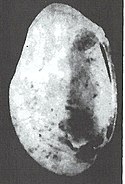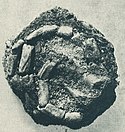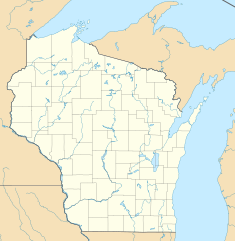Walker-Hooper Site
| Walker-Hooper Site (47-GL-65) | |
|---|---|
 | |
| Location | Green Lake County, Wisconsin |
| Coordinates | 43°43′44″N 89°15′54″W / 43.72889°N 89.26500°W |
| Area | 60 acres |
Location in Wisconsin | |
The Walker-Hooper Site (47-GL-65) is a multicomponent prehistoric site complex located on the Grand River in the Upper Fox River drainage area in Green Lake County, Wisconsin. It consisted of at least 2 village sites and several mound groups (all of which are destroyed today). It was excavated by S.A. Barrett under the auspices of the Milwaukee Public Museum in 1921 and again in 1967 by Guy Gibbon of the University of Wisconsin-Milwaukee. The major component of the site is an Upper Mississippian Oneota palisaded village. Other components were also present, mainly Late Woodland but also including Archaic, Early Woodland and Middle Woodland.[1][2]
Site Environment[edit]
The site is located in the Carolinian Biotic Province as defined by Cleland.[3] The environment of the immediate site surroundings included prairie, oak-hickory forest and marshland.[1]
Summary of 1921 excavations[edit]

The 1921 excavations focused on the burial mounds present on the site. There were at least 6 groups of mounds, and a total of 38 burials were recovered. Mound 1 of Mound Group 4 was interesting in that it was shaped in the form of a bear effigy.[2]
Of the 38 burials, 23 were flexed, 8 were extended and 7 were indeterminate due to poor preservation or disturbance. The adults were almost all flexed, while the extended burials were generally infant or child burials. Grave goods were present in some burials, including pottery vessels and other artifacts. Some burials contained charcoal, implying a fire was built as part of the burial ceremony.[2]
In addition, several “camp sites” and refuse pits were excavated, which contained animal bone, pot sherds, shell fragments and stone and bone tools and fragments.[2]
The following artifacts were recovered from the 1921 excavations:[2]
- Chipped stone - only a quartzite projectile point was reported, which was included in a burial
- Ground stone - including an adze, a spade and fragmentary celts and axes
- Bone and antler - including a bear tusk pendant, phalangeal bone pendant, bone awls, bone beads, a harpoon, fish hooks, antler flakers, scrapers and an antler projectile point
- Shell - including unio shell pendants and shell spoons
- Copper - including a bracelet, beads, a serpent-shaped pendant, an awl and a celt
Some of these artifacts are illustrated and discussed further below.
Summary of 1967 excavations[edit]


The 1967 excavations yielded 2 rows of post molds interpreted as palisades; 2 oval-shaped houses; sheet middens; and 66 cache and refuse pits containing cultural debris such as pot sherds, lithic debitage and animal bone.[1]
The houses measured 35 x 10 feet and 20 x 11 feet. Similar houses at the Huber Phase sites of Anker[4] and Oak Forest[5] in the Chicago area measured from 25–55 feet wide by 12–15 feet wide. The cache and refuse pits were located both within and outside the structures, although the ones outside structures tended to be larger.[1]
The following artifacts were recovered from the 1967 excavations:[1]
- Chipped stone - including 93 projectile points (including 78 triangular Madison points), 13 wedges, 6 gouges, 29 notched flakes, 9 gravers, 19 bifacial knives, 2 Kolterman indented-base knives, 5 small ovate knives, 12 end scrapers and 6 side scrapers
- Ground stone - including 16 hammerstones, 1 anvil, 1 pottery polishing pebble, 8 grinding stones, 2 ground stone pendants, 4 hoes, 4 paint stones and 5 adzes
- Bone and antler - including 6 antler projectile points, 13 deer tine flakers, 4 beaver incisor chisels, 5 bone punches, 4 deer metapodial awls, 4 deer scapula awls, 1 canine ulna awl, 1 bird bone awl, 8 flat splinter awls, 6 deer jaw sickles, 7 cannon bone beamers, 1 deer humerus gouge, 2 human tooth pendants, 1 canine tooth pendant and 3 bird bone tubes/ornaments
- Shell - including 4 fishing lures, 11 shell scrapers and 6 shell spoons
- Copper - including 4 pendants
- Pottery sherd - 12 pottery sherd discs similar in temper and paste to the Oneota pottery found on the site
- Clay - 1 clay spoon, 1 fragmentary clay smoking pipe and 1 ear spool
Some of these artifacts are illustrated and discussed further below.
Results of data analysis[edit]
Animal remains[edit]
Animal remains were only reported from the 1967 excavations. The major species were deer and fish (especially freshwater drum, bass and northern pike). Some of the other species present were mussels, beaver, elk, dog, bear, otter, duck and common loon.[1] These remains were not modified into tools like the bone tools described elsewhere in this article, and may be considered food remains or, in the case of the dog and bear, possibly the remains of ceremonial activities. Dog sacrifice and dog meat consumption was observed to have ceremonial and religious implications in early Native American tribes. Bear worship and ceremonialism has also been recorded in the ethnological record.[6]
Many of the bones were deliberately smashed, implying they were extracting marrow or bone grease.[1]
Significantly, the estimated pounds of meat of the fish bones recovered indicate that fish provided an equal portion of the diet compared to the mammal bone, which means the inhabitants were heavily reliant on aquatic resources.[1]
Despite a close proximity to prairie habitat, there were no bison remains recovered from the site. It has been suggested that bison did not range east of the Mississippi River until after A.D. 1600.[7]
Plant remains[edit]
Plant remains were only reported from the 1967 excavations. Maize cobs and kernels, and hickory nut shell, were the most abundant. Present in trace amounts were beans, squash, acorn and hazelnut.[1]
The hickory nut shell was smashed into small pieces which implies that the inhabitants were smashing the nuts, boiling in water and skimming the oil off the top.[1]
Artifacts[edit]
Pottery artifacts[edit]

Archaeologists often find pottery to be a very useful tool in analyzing a prehistoric culture. It is usually very plentiful at a site and the details of manufacture and decoration are very sensitive indicators of time, space and culture.[8]
The 1921 excavations yielded several complete vessels associated with burials. However, these were not analyzed or assigned to a formal typology. During the 1967 excavations, no whole or reconstructable vessels were recovered from the site, so the analysis was based upon examination of rim and body sherds. Due to the large number of very small sherds, an effort was made to convert a raw sherd count into an estimated minimum number of vessels present. This provided a more accurate estimate of the relative proportions of pottery types represented.[1]
The 1967 pottery was assigned to formal types. Several pottery types from different time periods were present. Some of them are listed below:[1]
| Type | No. of vessels | Tempering material | Description | Cultural affiliation |
|---|---|---|---|---|
| Carcajou curvilinear[9] | 1 | Shell | Consists of shell-tempered, globular jars with restricted orifice, well-defined shoulders, everted rim profile and notched lips. Surface finish is smooth and decoration is applied between the neck and shoulder in the form of interlocking scrolls sometimes with hatched areas, and meanders. Occasionally handles are present. Early examples have angular shoulders. Grand River trailed is similar except for the notched lips. | Upper Mississippian Oneota (Koshkonong and Grand River Foci) |
| Carcajou plain[9] | 28 | Shell | Same as Carcajou curvilinear except decoration is limited to lip notching | Upper Mississippian Oneota (Koshkonong and Grand River Foci) |
| Grand River trailed[9] | 3 | Shell | Consists of shell-tempered, globular jars with restricted orifice, well-defined shoulders and everted rim profile. Rims are not notched. Surface finish is smooth and decoration is applied between the neck and shoulder in the form of interlocking scrolls , meanders, linear and circular, crescent-shaped and similar elements arranged in patterns. Handles are rare. Carcajou Curvilinear is similar except for the notched lips | Upper Mississippian Oneota (Koshkonong and Grand River Foci) |
| Grand River plain[9] | 59 | Shell | Same as Grand River trailed except no decoration | Upper Mississippian Oneota (Koshkonong and Grand River Foci) |
| Busseyville grooved paddle[9] | 2 | Shell | Consists of shell-tempered, globular vessels with everted rim profile, squared lip and grooved-paddle impressed surface finish. Similar to Fort Ancient pottery from the Madisonville focus[10] and Danner Paddle-Impressed from the Danner Component of the Zimmerman site | Unknown |
| Point Sauble collared[11] | 1 | Grit | Cord-impressed surface, collared rim, row of punctates beneath collar | Late Woodland |
| Madison plain[12] | 7 | Grit | Plain surface; some vessels have cord impressions on lip | Late Woodland / Effigy Mound |
| Madison cord-impressed[12] | 2 | Grit | Cord-impressed decoration; globular vessel form with restricted orifice and slightly everted rim profile | Late Woodland / Effigy Mound |
Other artifacts[edit]
The non-pottery artifacts found at an archaeological site can provide useful cultural context as well as a glimpse into the domestic tasks performed at a site; ceremonial or religious activities; recreational activities; and clothing or personal adornment.
Some of the most prominent and diagnostic non-pottery artifacts are presented here in more detail:
| Material | Description | Image | Qty | Function / use | Comments / associations |
|---|---|---|---|---|---|
| Chipped stone | Small triangular points (aka Madison points) | 
|
24 | Hunting/fishing/warfare | Also known as “arrowheads”; are thought to be arrow-tips for bows-and-arrows. The usage of the bow-and-arrow seems to have greatly increased after A.D. 1000, probably as a result of increased conflict.[13][14] |
| Bone | Deer jaw sickles | 
|
6 | Domestic function / used for scraping maize kernels off the cobs | The presence of these sickles is an indicator of the practice of maize agriculture at the site[15] |
| Shell | Fish lures | 
|
4 | Fishing function | Fish remains were common among the animal bone recovered from the site |
| Shell | Spoons | 
|
4 | Domestic function / food preparation-serving | Shell spoons were found as grave goods at the Gentleman Farm site[16] and Fisher Mound Group;[17] they were also present in the Upper Mississippian Heally Complex at the Zimmerman site[18][19] |
| Wood | Wooden vessel | 
|
1 | Domestic function / food preparation-serving | Found with a burial; wooden implements are extremely rare in Prehistoric sites because of preservation. This vessel was partially carbonized which prevented it from decaying naturally |
| Bone | Grooved bone | 1 | Unknown | Very rare artifact with unknown function; a similar specimen was recovered from the Moccasin Bluff site in southwest Michigan[15] | |
| Bone | Harpoon | 1 | Fishing function | Similar harpoons have been recovered from the Fisher Mound Group in Illinois[17] and Fifield Site in Indiana[20] | |
| Bone | Bear tusk pendant | 1 | Personal adornment and/or ceremonial function | Bear ceremonialism was noted among the early Native American tribes[6] | |
| Bone | Fish hooks | 
|
2 | Fishing function | Fish remains were common among the animal bone recovered from the site |
| Copper | Bracelet | 
|
1 | Personal adornment and/or ceremonial function | Bracelet made from copper beads found in a child burial; the photo shows the bracelet in place as it was found on the skeleton |
| Copper | Serpent-shaped Pendant | 
|
1 | Personal adornment and/or ceremonial function | Probably worn as a pendant |
Grand River focus[edit]
The Walker-Hooper site is the type site of the Grand River focus of the Oneota Aspect, based primarily on details of the pottery. In particular, the Grand River focus pottery tends to have more plain undecorated vessels (other than lip decoration) and handles are very rare. Punctate decoration is also particularly rare. Besides the pottery, Grand River sites are also more often associated with burial mounds.[1][13]
Along with the Koshkonong and Green Bay Foci, the Grand River focus is considered part of the Developmental Horizon of the Oneota Aspect, dating to approximately A.D. 1000-1300. The radiocarbon dates obtained from the Walker-Hooper site accordingly range from A.D. 1200-1240. The site is thought to have been occupied during a relatively short interval. Based upon the animal and plant remains, it is thought to have been a summer seasonal agricultural village.[1]
References[edit]
- ^ a b c d e f g h i j k l m n Gibbon, Guy E. (1972). "The Walker-Hooper Site: A Grand River Phase Oneota Site in Green Lake County". The Wisconsin Archaeologist. 53 (4): 149–290.
- ^ a b c d e Jeske, John A. (1927). "The Grand River Mound Group and Camp Site". Bulletin of the Public Museum of the City of Milwaukee. 3 (2): 139–214.
- ^ Cleland, Charles E. (1966). The Prehistoric Animal Ecology and Ethnozoology of the Upper Great Lakes Region. Ann Arbor, Michigan: University of Michigan Museum of Anthropology, Anthropological Papers No. 29.
- ^ Bluhm, Elaine A.; Liss, Allen (1961). Bluhm, Elaine A. (ed.). Chicago Area Archaeology. Urbana, Illinois: Illinois Archaeological Survey, Bulletin No. 3.
- ^ Bluhm, Elaine A.; Fenner, Gloria J. (1961). "The Oak Forest Site". In Bluhm, Elaine A. (ed.). Chicago Area Archaeology. Urbana, Illinois: Illinois Archaeological Survey, Bulletin No. 3.
- ^ a b Koziarski, Ralph (2017). "Fur-Trade Period Animal Ceremonialism at the Grand Village of the Meskwaki". Midcontinental Journal of Archaeology. 42 (1): 37–57. doi:10.1080/01461109.2017.1292671. S2CID 164815598.
- ^ Gibbon, Guy E. (1972). "Cultural Dynamics and the Development of the Oneota Life-Way in Wisconsin". American Antiquity. 37 (2): 166–185. doi:10.2307/278204. JSTOR 278204.
- ^ Shepard, Anna O. (1954). Ceramics for the Archaeologist. Washington, D.C.: Carnegie Institution of Washington, Publication No. 609.
- ^ a b c d e Hall, Robert L. (1962). The Archaeology of Carcajou Point. Madison, Wisconsin: University of Wisconsin Press.
- ^ Griffin, James Bennett (1943). The Fort Ancient Aspect: Its Cultural and Chronological Position in Mississippi Valley Archaeology (1966 ed.). Ann Arbor, Michigan: University of Michigan Museum of Anthropology.
- ^ Baerreis, David A.; Freeman, Joan E. (1958). "Late Woodland Pottery in Wisconsin as seen from Aztalan". The Wisconsin Archaeologist. 39 (1): 35–61.
- ^ a b Keslin, Richard O. (1958). "A Preliminary Report of the Hahn (Dg1 and Dg2) and Horicon (Dg5) Sites, Dodge County, Wisconsin". The Wisconsin Archaeologist. 39 (4): 191–273.
- ^ a b Mason, Ronald J. (1981). Great Lakes Archaeology. New York, New York: Academic Press, Inc.
- ^ Lepper, Bradley T. (2005). Ohio Archaeology (4th ed.). Wilmington, Ohio: Orange Frazer Press.
- ^ a b Bettarel, Robert Louis; Smith, Hale G. (1973). The Moccasin Bluff site and the Woodland Cultures of Southwest Michigan. Ann Arbor, Michigan: University of Michigan Museum of Anthropology, Anthropological Papers No. 49.
- ^ Brown, James A. (1967). The Gentleman Farm Site. Springfield, Illinois: Illinois State Museum, Report of Investigations No. 12.
- ^ a b Langford, George (1927). "The Fisher Mound Group: Successive Aboriginal Occupations near the Mouth of the Illinois River". American Anthropologist. 29 (3): 152–206. doi:10.1525/aa.1927.29.3.02a00260.
- ^ Brown, James A. (1961). The Zimmerman Site: A Report on Excavations at the Grand Village of Kaskaskia, La Salle County, Illinois. Springfield, Illinois: Illinois State Museum, Report of Investigations No. 9.
- ^ Brown, Margaret Kimball (1975). The Zimmerman Site: Further Excavations at the Grand Village of the Kaskaskia. Springfield, Illinois: Illinois State Museum, Report of Investigations No. 32.
- ^ Faulkner, Charles H. (1972). "The Late Prehistoric Occupation of Northwestern Indiana: A Study of the Upper Mississippi Cultures of the Kankakee Valley". Prehistory Research Series. V (1): 1–222.
Further reading[edit]
- Guy E. Gibbon (1972), "The Walker-Hooper Site: A Grand River Phase Oneota Site in Green Lake County", Wisconsin Archaeologist, 53 (4): 149–290
- John A. Jeske (1927), "The Grand River Mound Group and Camp Site", Bulletin of the Public Museum of the City of Milwaukee, 3 (2): 139–214



